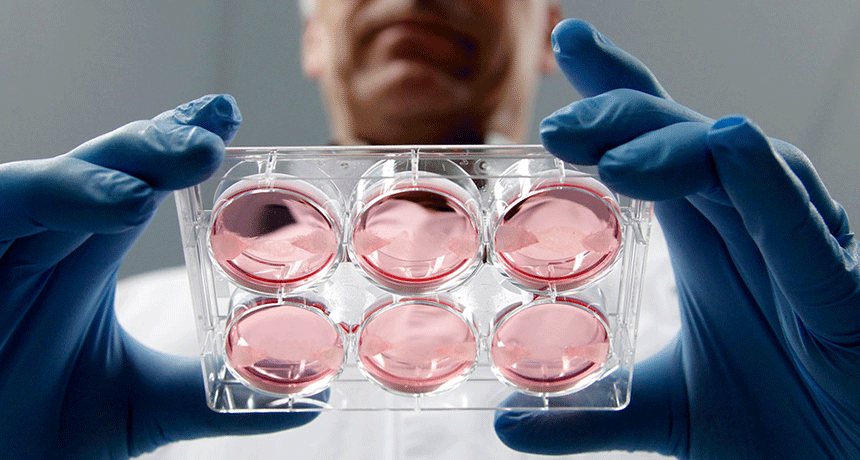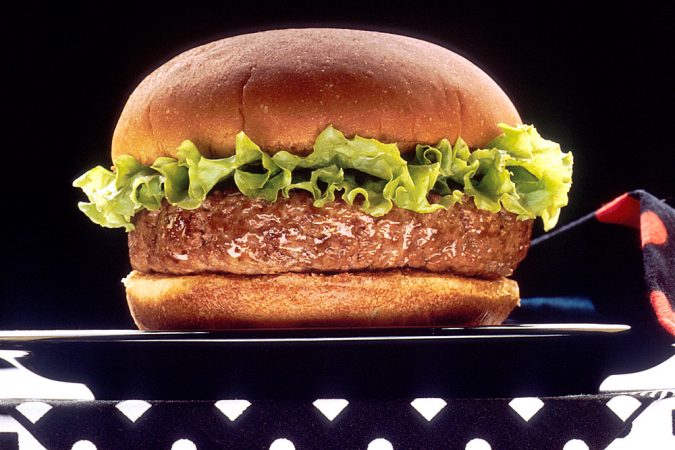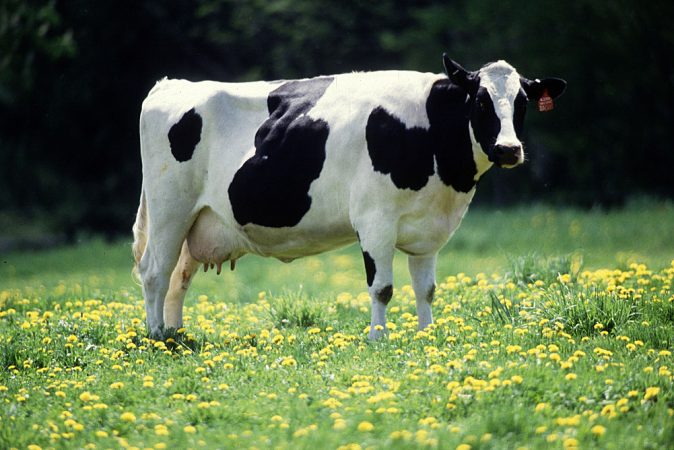Meat from scratch
Scientists are working to produce meat without killing animals

Biologist Mark Post holds a sample of the engineered meat he’s growing in his Dutch lab.
REUTERS
If all goes according to Mark Post’s plan, he will appear on television in October and devour a hamburger that costs about twice as much as most houses do in the United States. Yes, as Charlotte the spider might have written, that’s some burger.
“It’s not something you’d flip every day on the barbecue,” admits Post, a biologist at Maastricht University in the Netherlands. The burger’s price — roughly $330,000, or about 250,000 Euros — might break a record for the most expensive ever.
But that won’t be the biggest reason for its making history. The burger will look like meat, and be cooked like meat, but no animal will have been killed to make it. Under a microscope, the patty’s cells will look identical to those from animal muscles, the source of conventional meat. Post says he wants this publicity to make people think hard about food of the future.
The population of the planet is increasing, which boosts the demand for meat. The amount of land available for raising livestock probably won’t be able to meet the increasing demand for much longer.
Moreover, raising animals for food can take a toll on the environment: The practice increases pollution and boosts levels of greenhouse gases, which increase global warming. For many reasons, scientists like Post — as well as organizations that oppose the killing of animals — think it’s time to find a new source for meat in our diet.
Post uses chemistry, biology and creativity to grow meat in glass dishes. The laboratory creations are white because they don’t contain blood (which colors meat red), and Post describes them as rubbery, “sort of like a piece of squid.”
Post says he has about 20 strips of would-be meat growing at a time, each about 6 inches (15 centimeters) long. The scientist estimates he’ll need 3,000 of the little gummies to build an entire burger. That means that between now and October, he’s going to be very busy.
Growing a new meat product from scratch means he must start with cells and then work his way up. It requires know-how in scientific fields like agriculture, nutrition and biology. Most of all, it requires the attention and work of scientists who tinker, experiment and create — and who believe engineered meat would improve life on Earth.
Dishing it out
Some people call the meat “lab-grown,” “engineered” or “cultured.” Others prefer the description “in vitro,” which means from a test tube or lab dish. People who dislike the idea of bypassing cattle to get their beef might refer to Post’s goal as a “Frankenburger” (as though it were created by a mad scientist like Dr. Frankenstein.)
The names may differ, but the idea is the same: a quest for less-costly and less-polluting sources of animal protein.

In 1912, French biologist Alexis Carrel removed part of a chicken heart and kept it beating in a lab dish. This demonstrated that tissue can be kept alive outside the body. Two decades later, British prime minister Winston Churchill declared his optimism for lab-grown meat: “Fifty years hence we shall escape the absurdity of growing a whole chicken in order to eat the breast or wing by growing these parts separately under a suitable medium.”
Churchill was overconfident: No one ate engineered chicken in 1982. But if scientists today succeed, it might be a regular menu item by 2082.
NASA, the U.S. space agency, took an interest in lab-grown meat during the 1990s. Engineered meat would provide a good source of protein for astronauts (especially after they tire of freeze-dried fruit and ice cream). In 2002, NASA-funded experiments produced fish nuggets grown in a lab.
“They essentially took a filet from large goldfish” and then cultivated it to grow new tissue in a nutrient broth made from mushrooms, explains Nicholas Genovese, a biologist at the University of Missouri-Columbia. The goldfish filet study, he says, introduced the idea of engineered meat to a wider audience, including interested scientists.
Genovese says scientists have been creating meat in laboratories since at least the early 1990s. But they weren’t calling their first products “meat,” or talking about using them for food. Instead, those scientists established what could be done, or what’s called “proof of principle.” Since then, the science has blossomed.
The scientific pursuit of growing meat outside of an animal has been helped by an expanding interest in stem cells. These cells, found in many parts of the body, can become different types of cells and are the basis of research by scientists like Post and Genovese.
A growing awareness that livestock production can harm the environment has further encouraged interest in growing meat from stem cells. Pesticides, as well as drugs fed to animals to keep them healthy, pollute the soil. The process of growing, harvesting and eating animals contributes greenhouse gases like methane and carbon dioxide to the atmosphere. Clearing forests to make more room for animals removes trees, which naturally soak up some of the carbon dioxide.
“It’s not very environmentally friendly,” Post says of livestock production.
If diners learn to accept engineered meat, this could ease the pollution associated with meat production, argues Post. He also notes that, unlike meat from animals, engineered meat can be fine-tuned to offer improved health benefits. Studies have linked high consumption of red meat to a variety of diseases, including many types of cancer. Post hopes that in the future, scientists may be able to boost engineered meat’s nutritional content and reduce health risks by tweaking the growing process.

That’s probably far in the future. Right now, scientists are racing to get the first sample of lab-grown meat on the shelves. In order to succeed, says Genovese, scientists have to create something that’s edible, nutritious, affordable and easy to produce. That’s going to take time, and Genovese thinks success will depend on future scientists.
“Right now, in vitro meat is where computers were in the 1970s,” Genovese says. Although primitive versions exist, he points out, it may be a decade or more before people have easy access to affordable products that offer major benefits to health and the environment.
Inside the new meat
Post’s recipe for this next-generation meat sounds straightforward: Take some cells from an animal without killing it, add nutrients and put the mixture in a lab dish. Then watch the meat grow.
But you can’t use just any random cell to grow meat. Muscles, the part of an animal that’s consumed as meat, contain a wide variety of cells, including stem cells. Within muscle, stem cells can grow into muscle cells and replace those that are lost or damaged. Bone stem cells grow to become new bone cells. Some types of stem cells, called pluripotent stem cells, are like blank slates. They can grow into any type of tissue.
Biology and medicine have taken a keen interest in stem cells lately. Types of these versatile cells can play a role in both the spread and treatment of cancer. Stem cells also figure prominently in the proposed treatments for many other diseases. In the future, for instance, stem cells may be used to treat Alzheimer’s disease, spinal cord injury, stroke, burns, heart disease, diabetes and arthritis. Other scientists think that stem cells can be coaxed to grow into entire organs outside the body, which means someone who needs a new liver might get one from a lab, not an organ donor. New medications might even be tested first on stem cells to see if the drugs are safe and effective.
Now, meat engineers have begun eyeing stem cells. When the body needs to produce new skeletal muscle cells — those long and strong cells that allow us to reach and stretch and lift and push — stem cells jump into action. They can become new skeletal muscle cells, dividing quickly and offering support to the body’s frame. Stem cells also help muscles grow larger and repair injuries. They divide quickly, creating an organized, sprawling family of new skeletal muscle cells.
In his laboratory, Post starts out with individual stem cells taken from animals at the slaughterhouse. He places them in a gel that contains nutrients, or cell food. He anchors the cells in place with off-the-shelf hook-and-loop tape (such as Velcro), sterilized to keep unwanted germs away. Then the cells start dividing, creating new tissue that grows and expands.
In order to grow and become strong, muscle has to do work, and it’s no different for engineered meat. “If you don’t use a muscle, it wastes,” Post says. He and his team have to make the cells perform labor in the culture dish, which isn’t easy. The scientists sometimes use electrical shocks to force the tissue to contract, which helps it produce more proteins and grow stronger. “If you zap them, they grow more vigorous and robust,” he explains.
“Protein is what makes muscle contract, since a muscle is basically a bag full of protein.”
Although those shocks of electricity are useful, they can also pose a problem. One argument for producing meat in the lab is that animals use a lot of energy to produce a kilogram of meat. To make one kilogram of beef, for example, a cow has to eat seven kilograms of grain — and that feed has to be grown. Using electricity to stimulate meat to grow in a lab adds energy to the process. “It’s a waste,” Post says. He’d like to find a way to grow meat without such electrical needs.
Genovese points out other limitations. For example, stem cells divide only a limited number of times before they stop. If scientists have to harvest a lot of stem cells to create engineered meat, then the process still relies heavily on real, live animals for the starter stem cells. “If for every one cell you harvest from an animal, you get 10 billion cells, maybe then it can become efficient.”
A meaty prize
Though obstacles remain, scientists like Post and Genovese are optimistic. They’re not the only people interested and invested in the future of meat products. People for the Ethical Treatment of Animals, or PETA, is an animal-rights organization. It has offered $1 million to the first scientist who creates and sells chicken meat grown in a laboratory (rather than in an actual bird). (Post can’t win: He’s creating new beef, not chicken.) The project that bags the PETA prize has to be identical to chicken in every way — including taste, texture and appearance.
Ten PETA judges will taste-test competing products, prepared according to a fried chicken recipe, to see which ones are most chicken-like. PETA has also funded Genovese ‘s research.
In the meantime, watch for Post’s televised dinner in October. It might signal the first step toward a future where engineered meat is on supermarket shelves. With a lot of work and money, and plenty of luck, future generations may eat meat not from an animal but from a specialized store, says Genovese.
“You might imagine that in 10 or 20 years from now, just like bread is produced in a bakery, and wine is produced in a winery, cultured meat will be produced in a carnery,” he says. “The word’s just not in the dictionary yet.”
Power Words (adapted from the New Oxford American Dictionary)
biology The study of living things.
greenhouse gas A gas that contributes to Earth’s greenhouse, or warming, effect by trapping and absorbing heat.
cell The smallest structural and functional unit of an organism, typically microscopic and enclosed in a membrane.
stem cell A cell of a multicellular organism that can develop more cells of the same type, sometimes indefinitely. Some stem cells can develop into almost any cell in the body.
skeletal muscle A muscle that is connected to the skeleton to form part of the mechanical system that moves the limbs and other parts of the body.
pesticide A substance used for destroying insects or other organisms harmful to cultivated plants or to animals.
Word Find (click here to print puzzle)








